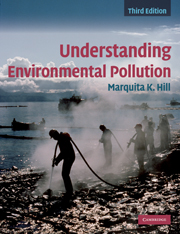Book contents
- Frontmatter
- Contents
- Preface
- Acknowledgements
- List of abbreviations and acronyms
- 1 Understanding pollution
- 2 Reducing risk, reducing pollution
- 3 Chemical toxicity
- 4 Chemical exposures and risk assessment
- 5 Air pollution
- 6 Acid deposition
- 7 Global climate change
- 8 Stratospheric ozone depletion
- 9 Water pollution
- 10 Drinking-water pollution
- 11 Solid waste
- 12 Hazardous waste
- 13 Energy
- 14 Persistent, bioaccumulative, and toxic
- 15 Metals
- 16 Pesticides
- 17 Pollution at home
- 18 Zero waste, zero emissions
- 19 Chemistry: some basic concepts
- Index
- References
2 - Reducing risk, reducing pollution
Published online by Cambridge University Press: 05 June 2012
- Frontmatter
- Contents
- Preface
- Acknowledgements
- List of abbreviations and acronyms
- 1 Understanding pollution
- 2 Reducing risk, reducing pollution
- 3 Chemical toxicity
- 4 Chemical exposures and risk assessment
- 5 Air pollution
- 6 Acid deposition
- 7 Global climate change
- 8 Stratospheric ozone depletion
- 9 Water pollution
- 10 Drinking-water pollution
- 11 Solid waste
- 12 Hazardous waste
- 13 Energy
- 14 Persistent, bioaccumulative, and toxic
- 15 Metals
- 16 Pesticides
- 17 Pollution at home
- 18 Zero waste, zero emissions
- 19 Chemistry: some basic concepts
- Index
- References
Summary
“We aren't passengers on Spaceship Earth; we're the crew. We aren't residents of this planet; we're citizens. The difference in both cases is responsibility.”
Astronaut Rusty SchweikartSome pollution problems are daunting; others less so. This chapter begins with a brief overview as to how we can separate the “trivial” from the serious, whether the risk of a chemical or of a broader environmental problem. The chapter emphasis is on preventing or controlling pollution. Also introduced are the tools that assist us in moving toward sustainable societies. Section I introduces risk assessment concepts, how to evaluate the magnitude of a given risk, chemical risk assessment, and comparative risk assessment. Section II asks, how do we reduce, even eliminate, pollution's risks? Legislation is important. Many laws stress trapping pollutants already produced. The pollution prevention (P2) paradigm, also called source reduction, is more effective. P2 involves changing a process so that it produces less pollution or, sometimes, none at all. Section III introduces industrial ecology (IE), which goes beyond P2. IE examines pollution holistically, searching for means to mesh the human enterprise into the natural environment. Some tools of IE are briefly examined including life-cycle assessment and design for the environment.
SECTION I
Risk assessment
For many years, society has struggled with the problem of how to evaluate environmental risks. Risk assessment tools have been developed over decades, and continue to be refined. ▪ Chemical risk assessment examines the risk of individual chemicals.
- Type
- Chapter
- Information
- Understanding Environmental Pollution , pp. 34 - 56Publisher: Cambridge University PressPrint publication year: 2010



